An Assessment of Inflation Target Policy: New Zealand and Norway
VerifiedAdded on 2023/02/01
|11
|3097
|77
Report
AI Summary
This report evaluates the inflation target policies of New Zealand and Norway, focusing on their success in maintaining price stability, managing unemployment, and promoting economic growth. It analyzes economic data from 2000 to 2017, comparing the countries' performance based on consumer price index, unemployment rate, and GDP growth. The report assesses how each nation utilized fiscal policy, including taxation and government expenditure, to mitigate the effects of the 2008/2009 global financial crisis. It also examines the challenges faced by Norway in implementing the inflation target policy, such as economic shocks and deteriorated terms of trade. The analysis highlights the different approaches and outcomes of each country's monetary and fiscal strategies, providing insights into their effectiveness in achieving economic stability and growth.
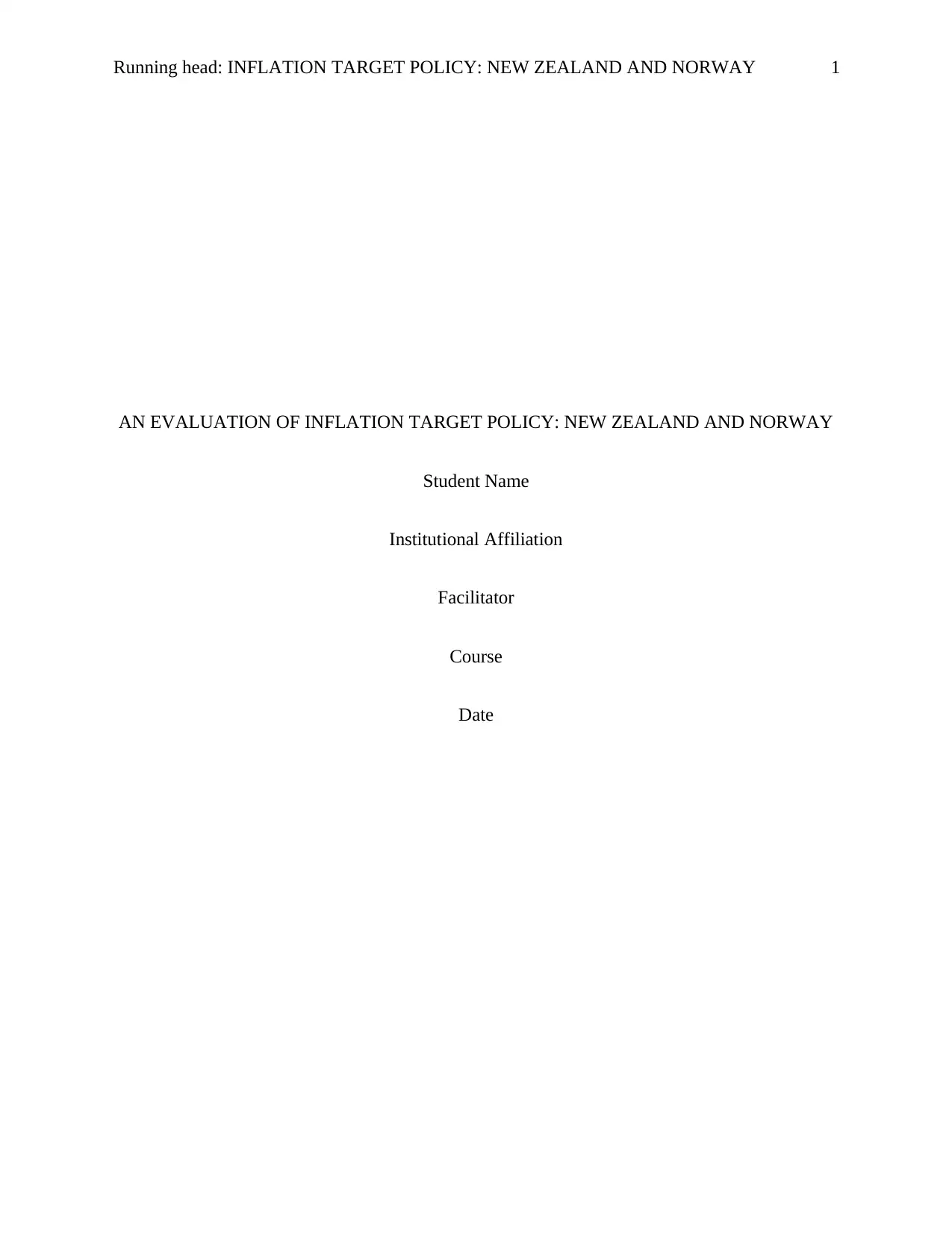
Running head: INFLATION TARGET POLICY: NEW ZEALAND AND NORWAY 1
AN EVALUATION OF INFLATION TARGET POLICY: NEW ZEALAND AND NORWAY
Student Name
Institutional Affiliation
Facilitator
Course
Date
AN EVALUATION OF INFLATION TARGET POLICY: NEW ZEALAND AND NORWAY
Student Name
Institutional Affiliation
Facilitator
Course
Date
Paraphrase This Document
Need a fresh take? Get an instant paraphrase of this document with our AI Paraphraser

INFLATION TARGET POLICY: NEW ZEALAND AND NORWAY 2
a. An assessment of the success of the inflation target policy by New Zealand and Norway
Inflation target policy as a tool of monetary policy is a policy utilized by the nation’s
central banks in order to meet the targeted inflation rates usually set on an annual basis
(Svensson, 2010). Consumer Price Index is the commonly used benchmark for inflation targeting
(De Gregorio, 2012). The policy is usually used by nations for various purposes the key ones
being promoting economic growth, maintaining stability in prices and reduction of
unemployment for the nations.
New Zealand was the first country to adopt the inflation target policy since the year 1990.
After that many nations proceeded to try it in their nations including Norway which adopted the
policy during the year 2000 (Roger, 2010). The following data for the two countries based on the
price stability as indicated by a consumer price index, unemployment rate, and the economic
growth rate has been used in evaluating the success of the two nations in promoting the three
economic indicators. The data has been extracted from the World Bank for the years 2000 to
2017 since Norway adopted the policy during the year 2000 and hence it may be difficult to
make a comparison between the nations for the past years since the adoption of the policy by
New Zealand during the year 1990.
Year
Unemployment Rate
(Annual %)
Consumer Price Index
(Annual %) GDP growth rate (Annual %)
New Zealand Norway New Zealand Norway New Zealand Norway
2000 6.15 3.43 2.62 3.09 2.29 3.21
2001 5.48 3.55 2.63 3.00 3.80 2.09
2002 5.30 3.89 2.68 1.29 5.06 1.44
2003 4.75 4.49 1.75 2.49 4.54 0.92
2004 4.03 4.47 2.29 0.45 3.27 3.96
2005 3.80 4.62 3.04 1.53 3.32 2.62
2006 3.88 3.44 3.37 2.33 2.57 2.40
2007 3.58 2.54 2.38 0.71 3.76 2.99
2008 4.00 2.75 3.96 3.75 -1.55 0.48
a. An assessment of the success of the inflation target policy by New Zealand and Norway
Inflation target policy as a tool of monetary policy is a policy utilized by the nation’s
central banks in order to meet the targeted inflation rates usually set on an annual basis
(Svensson, 2010). Consumer Price Index is the commonly used benchmark for inflation targeting
(De Gregorio, 2012). The policy is usually used by nations for various purposes the key ones
being promoting economic growth, maintaining stability in prices and reduction of
unemployment for the nations.
New Zealand was the first country to adopt the inflation target policy since the year 1990.
After that many nations proceeded to try it in their nations including Norway which adopted the
policy during the year 2000 (Roger, 2010). The following data for the two countries based on the
price stability as indicated by a consumer price index, unemployment rate, and the economic
growth rate has been used in evaluating the success of the two nations in promoting the three
economic indicators. The data has been extracted from the World Bank for the years 2000 to
2017 since Norway adopted the policy during the year 2000 and hence it may be difficult to
make a comparison between the nations for the past years since the adoption of the policy by
New Zealand during the year 1990.
Year
Unemployment Rate
(Annual %)
Consumer Price Index
(Annual %) GDP growth rate (Annual %)
New Zealand Norway New Zealand Norway New Zealand Norway
2000 6.15 3.43 2.62 3.09 2.29 3.21
2001 5.48 3.55 2.63 3.00 3.80 2.09
2002 5.30 3.89 2.68 1.29 5.06 1.44
2003 4.75 4.49 1.75 2.49 4.54 0.92
2004 4.03 4.47 2.29 0.45 3.27 3.96
2005 3.80 4.62 3.04 1.53 3.32 2.62
2006 3.88 3.44 3.37 2.33 2.57 2.40
2007 3.58 2.54 2.38 0.71 3.76 2.99
2008 4.00 2.75 3.96 3.75 -1.55 0.48
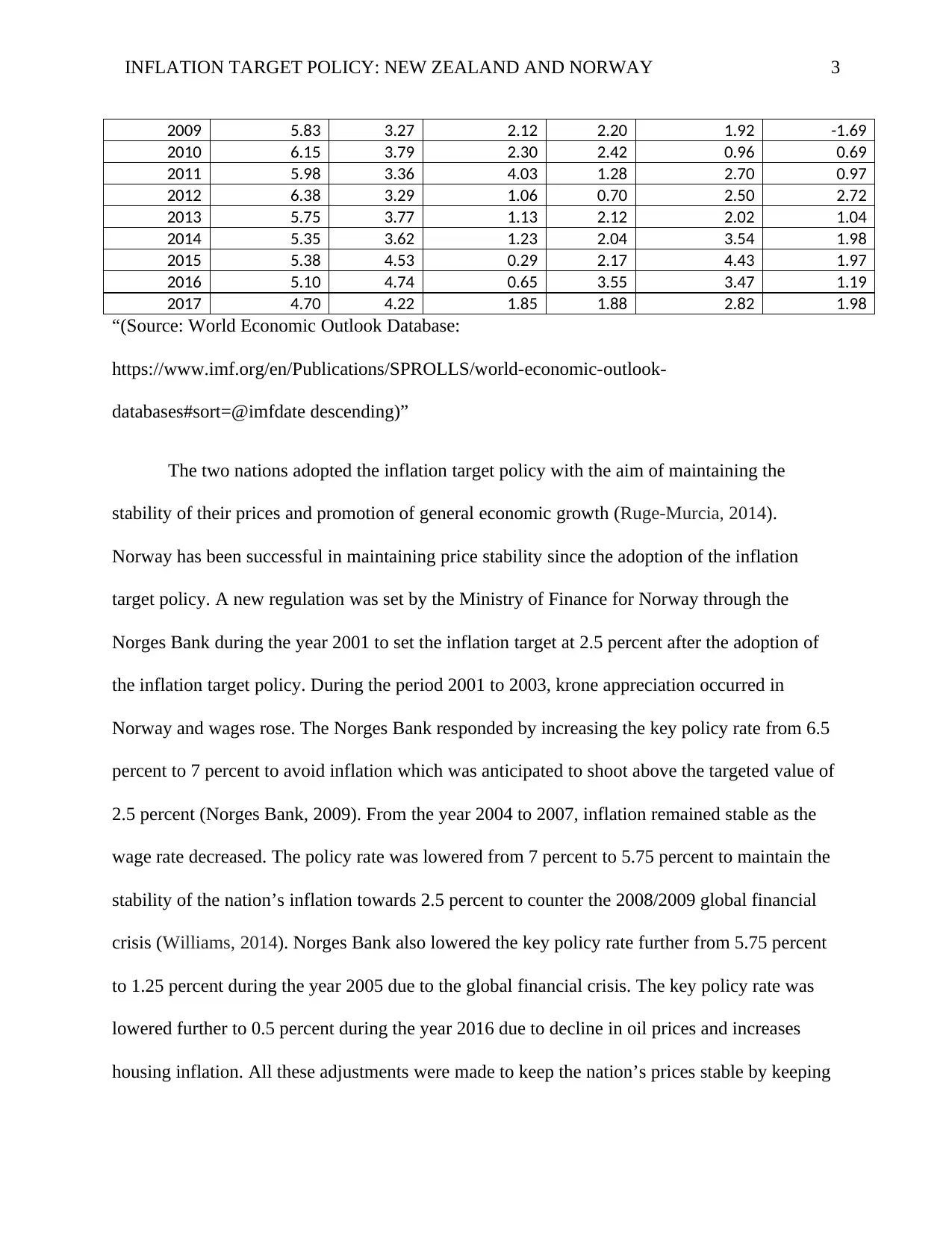
INFLATION TARGET POLICY: NEW ZEALAND AND NORWAY 3
2009 5.83 3.27 2.12 2.20 1.92 -1.69
2010 6.15 3.79 2.30 2.42 0.96 0.69
2011 5.98 3.36 4.03 1.28 2.70 0.97
2012 6.38 3.29 1.06 0.70 2.50 2.72
2013 5.75 3.77 1.13 2.12 2.02 1.04
2014 5.35 3.62 1.23 2.04 3.54 1.98
2015 5.38 4.53 0.29 2.17 4.43 1.97
2016 5.10 4.74 0.65 3.55 3.47 1.19
2017 4.70 4.22 1.85 1.88 2.82 1.98
“(Source: World Economic Outlook Database:
https://www.imf.org/en/Publications/SPROLLS/world-economic-outlook-
databases#sort=@imfdate descending)”
The two nations adopted the inflation target policy with the aim of maintaining the
stability of their prices and promotion of general economic growth (Ruge-Murcia, 2014).
Norway has been successful in maintaining price stability since the adoption of the inflation
target policy. A new regulation was set by the Ministry of Finance for Norway through the
Norges Bank during the year 2001 to set the inflation target at 2.5 percent after the adoption of
the inflation target policy. During the period 2001 to 2003, krone appreciation occurred in
Norway and wages rose. The Norges Bank responded by increasing the key policy rate from 6.5
percent to 7 percent to avoid inflation which was anticipated to shoot above the targeted value of
2.5 percent (Norges Bank, 2009). From the year 2004 to 2007, inflation remained stable as the
wage rate decreased. The policy rate was lowered from 7 percent to 5.75 percent to maintain the
stability of the nation’s inflation towards 2.5 percent to counter the 2008/2009 global financial
crisis (Williams, 2014). Norges Bank also lowered the key policy rate further from 5.75 percent
to 1.25 percent during the year 2005 due to the global financial crisis. The key policy rate was
lowered further to 0.5 percent during the year 2016 due to decline in oil prices and increases
housing inflation. All these adjustments were made to keep the nation’s prices stable by keeping
2009 5.83 3.27 2.12 2.20 1.92 -1.69
2010 6.15 3.79 2.30 2.42 0.96 0.69
2011 5.98 3.36 4.03 1.28 2.70 0.97
2012 6.38 3.29 1.06 0.70 2.50 2.72
2013 5.75 3.77 1.13 2.12 2.02 1.04
2014 5.35 3.62 1.23 2.04 3.54 1.98
2015 5.38 4.53 0.29 2.17 4.43 1.97
2016 5.10 4.74 0.65 3.55 3.47 1.19
2017 4.70 4.22 1.85 1.88 2.82 1.98
“(Source: World Economic Outlook Database:
https://www.imf.org/en/Publications/SPROLLS/world-economic-outlook-
databases#sort=@imfdate descending)”
The two nations adopted the inflation target policy with the aim of maintaining the
stability of their prices and promotion of general economic growth (Ruge-Murcia, 2014).
Norway has been successful in maintaining price stability since the adoption of the inflation
target policy. A new regulation was set by the Ministry of Finance for Norway through the
Norges Bank during the year 2001 to set the inflation target at 2.5 percent after the adoption of
the inflation target policy. During the period 2001 to 2003, krone appreciation occurred in
Norway and wages rose. The Norges Bank responded by increasing the key policy rate from 6.5
percent to 7 percent to avoid inflation which was anticipated to shoot above the targeted value of
2.5 percent (Norges Bank, 2009). From the year 2004 to 2007, inflation remained stable as the
wage rate decreased. The policy rate was lowered from 7 percent to 5.75 percent to maintain the
stability of the nation’s inflation towards 2.5 percent to counter the 2008/2009 global financial
crisis (Williams, 2014). Norges Bank also lowered the key policy rate further from 5.75 percent
to 1.25 percent during the year 2005 due to the global financial crisis. The key policy rate was
lowered further to 0.5 percent during the year 2016 due to decline in oil prices and increases
housing inflation. All these adjustments were made to keep the nation’s prices stable by keeping
⊘ This is a preview!⊘
Do you want full access?
Subscribe today to unlock all pages.

Trusted by 1+ million students worldwide
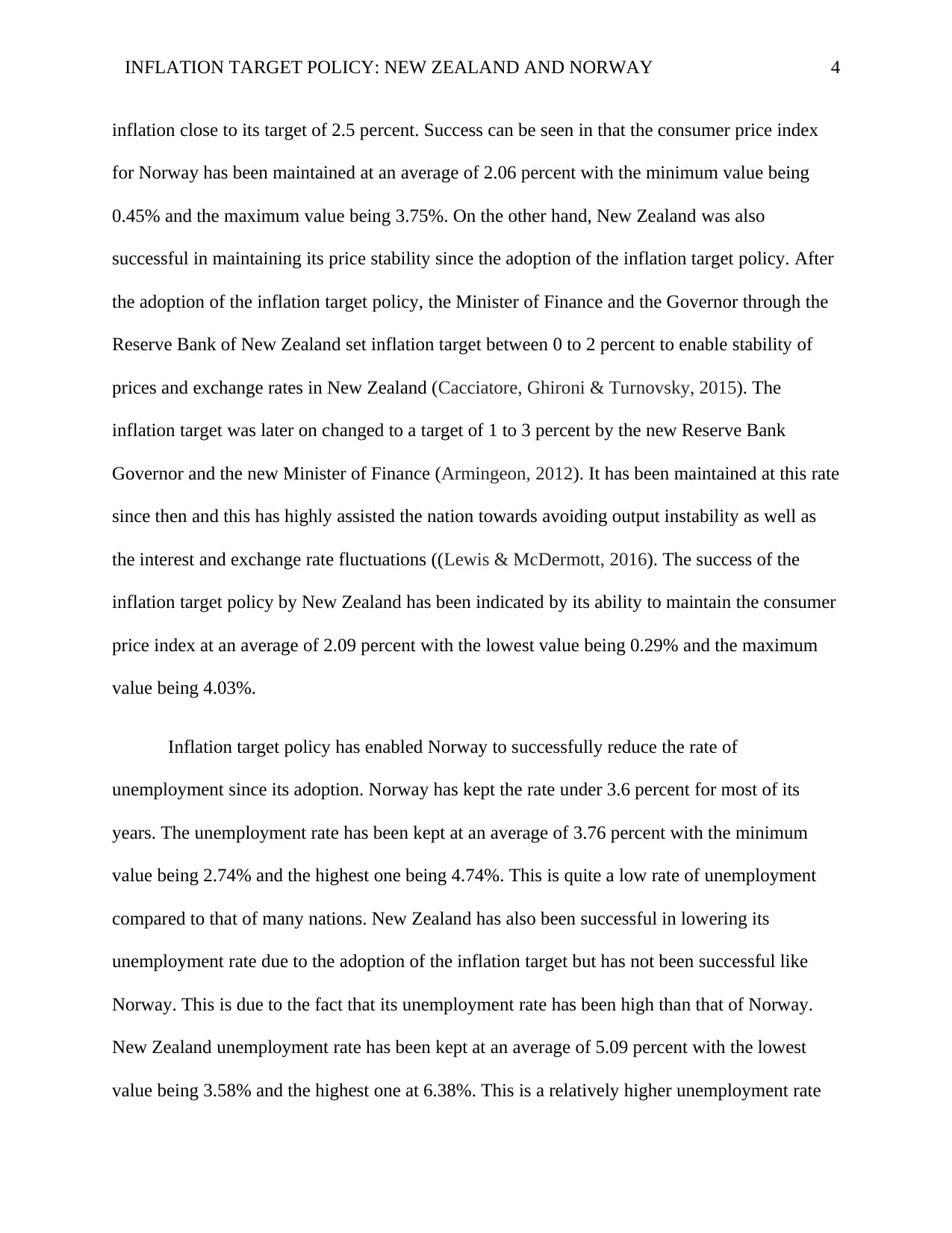
INFLATION TARGET POLICY: NEW ZEALAND AND NORWAY 4
inflation close to its target of 2.5 percent. Success can be seen in that the consumer price index
for Norway has been maintained at an average of 2.06 percent with the minimum value being
0.45% and the maximum value being 3.75%. On the other hand, New Zealand was also
successful in maintaining its price stability since the adoption of the inflation target policy. After
the adoption of the inflation target policy, the Minister of Finance and the Governor through the
Reserve Bank of New Zealand set inflation target between 0 to 2 percent to enable stability of
prices and exchange rates in New Zealand (Cacciatore, Ghironi & Turnovsky, 2015). The
inflation target was later on changed to a target of 1 to 3 percent by the new Reserve Bank
Governor and the new Minister of Finance (Armingeon, 2012). It has been maintained at this rate
since then and this has highly assisted the nation towards avoiding output instability as well as
the interest and exchange rate fluctuations ((Lewis & McDermott, 2016). The success of the
inflation target policy by New Zealand has been indicated by its ability to maintain the consumer
price index at an average of 2.09 percent with the lowest value being 0.29% and the maximum
value being 4.03%.
Inflation target policy has enabled Norway to successfully reduce the rate of
unemployment since its adoption. Norway has kept the rate under 3.6 percent for most of its
years. The unemployment rate has been kept at an average of 3.76 percent with the minimum
value being 2.74% and the highest one being 4.74%. This is quite a low rate of unemployment
compared to that of many nations. New Zealand has also been successful in lowering its
unemployment rate due to the adoption of the inflation target but has not been successful like
Norway. This is due to the fact that its unemployment rate has been high than that of Norway.
New Zealand unemployment rate has been kept at an average of 5.09 percent with the lowest
value being 3.58% and the highest one at 6.38%. This is a relatively higher unemployment rate
inflation close to its target of 2.5 percent. Success can be seen in that the consumer price index
for Norway has been maintained at an average of 2.06 percent with the minimum value being
0.45% and the maximum value being 3.75%. On the other hand, New Zealand was also
successful in maintaining its price stability since the adoption of the inflation target policy. After
the adoption of the inflation target policy, the Minister of Finance and the Governor through the
Reserve Bank of New Zealand set inflation target between 0 to 2 percent to enable stability of
prices and exchange rates in New Zealand (Cacciatore, Ghironi & Turnovsky, 2015). The
inflation target was later on changed to a target of 1 to 3 percent by the new Reserve Bank
Governor and the new Minister of Finance (Armingeon, 2012). It has been maintained at this rate
since then and this has highly assisted the nation towards avoiding output instability as well as
the interest and exchange rate fluctuations ((Lewis & McDermott, 2016). The success of the
inflation target policy by New Zealand has been indicated by its ability to maintain the consumer
price index at an average of 2.09 percent with the lowest value being 0.29% and the maximum
value being 4.03%.
Inflation target policy has enabled Norway to successfully reduce the rate of
unemployment since its adoption. Norway has kept the rate under 3.6 percent for most of its
years. The unemployment rate has been kept at an average of 3.76 percent with the minimum
value being 2.74% and the highest one being 4.74%. This is quite a low rate of unemployment
compared to that of many nations. New Zealand has also been successful in lowering its
unemployment rate due to the adoption of the inflation target but has not been successful like
Norway. This is due to the fact that its unemployment rate has been high than that of Norway.
New Zealand unemployment rate has been kept at an average of 5.09 percent with the lowest
value being 3.58% and the highest one at 6.38%. This is a relatively higher unemployment rate
Paraphrase This Document
Need a fresh take? Get an instant paraphrase of this document with our AI Paraphraser
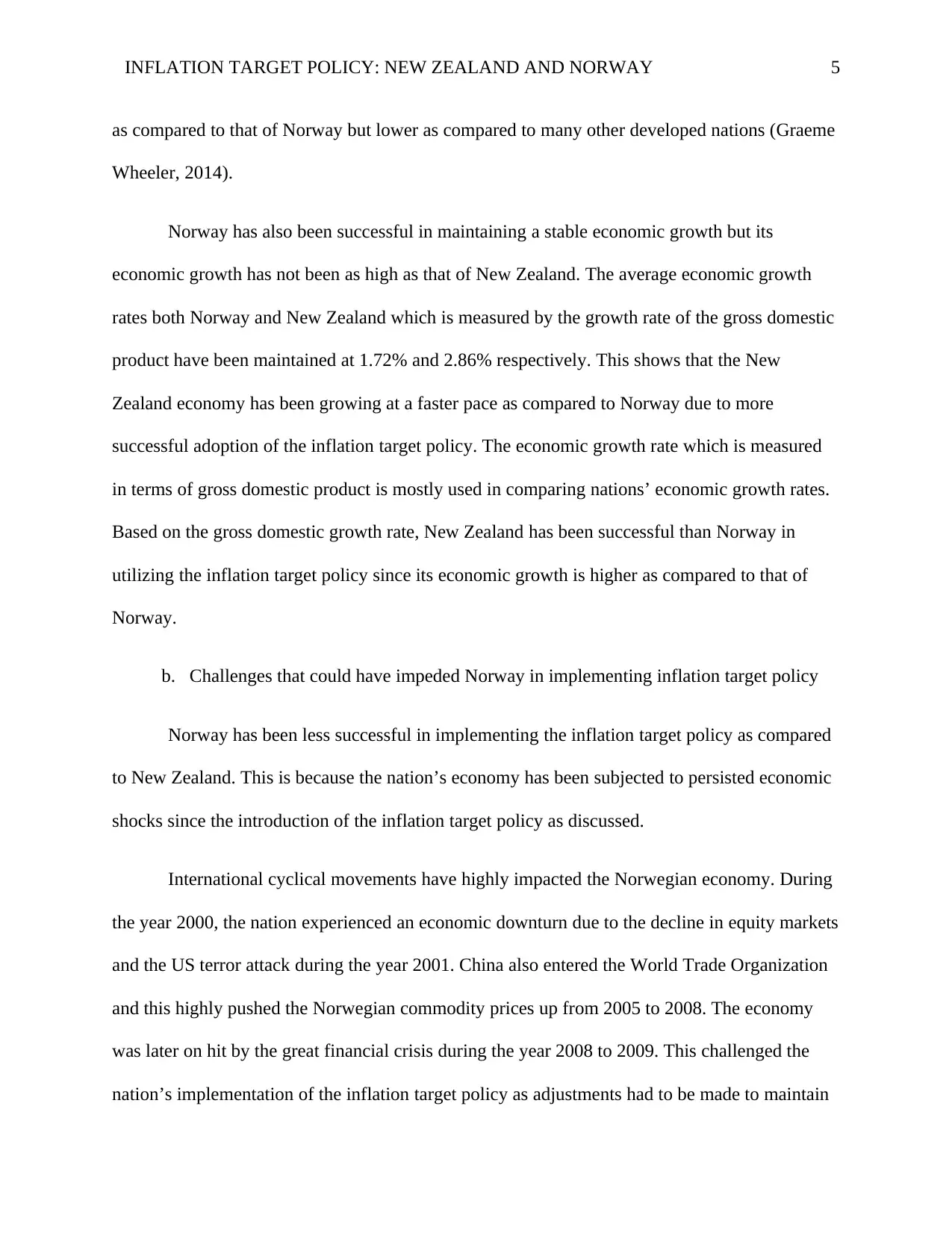
INFLATION TARGET POLICY: NEW ZEALAND AND NORWAY 5
as compared to that of Norway but lower as compared to many other developed nations (Graeme
Wheeler, 2014).
Norway has also been successful in maintaining a stable economic growth but its
economic growth has not been as high as that of New Zealand. The average economic growth
rates both Norway and New Zealand which is measured by the growth rate of the gross domestic
product have been maintained at 1.72% and 2.86% respectively. This shows that the New
Zealand economy has been growing at a faster pace as compared to Norway due to more
successful adoption of the inflation target policy. The economic growth rate which is measured
in terms of gross domestic product is mostly used in comparing nations’ economic growth rates.
Based on the gross domestic growth rate, New Zealand has been successful than Norway in
utilizing the inflation target policy since its economic growth is higher as compared to that of
Norway.
b. Challenges that could have impeded Norway in implementing inflation target policy
Norway has been less successful in implementing the inflation target policy as compared
to New Zealand. This is because the nation’s economy has been subjected to persisted economic
shocks since the introduction of the inflation target policy as discussed.
International cyclical movements have highly impacted the Norwegian economy. During
the year 2000, the nation experienced an economic downturn due to the decline in equity markets
and the US terror attack during the year 2001. China also entered the World Trade Organization
and this highly pushed the Norwegian commodity prices up from 2005 to 2008. The economy
was later on hit by the great financial crisis during the year 2008 to 2009. This challenged the
nation’s implementation of the inflation target policy as adjustments had to be made to maintain
as compared to that of Norway but lower as compared to many other developed nations (Graeme
Wheeler, 2014).
Norway has also been successful in maintaining a stable economic growth but its
economic growth has not been as high as that of New Zealand. The average economic growth
rates both Norway and New Zealand which is measured by the growth rate of the gross domestic
product have been maintained at 1.72% and 2.86% respectively. This shows that the New
Zealand economy has been growing at a faster pace as compared to Norway due to more
successful adoption of the inflation target policy. The economic growth rate which is measured
in terms of gross domestic product is mostly used in comparing nations’ economic growth rates.
Based on the gross domestic growth rate, New Zealand has been successful than Norway in
utilizing the inflation target policy since its economic growth is higher as compared to that of
Norway.
b. Challenges that could have impeded Norway in implementing inflation target policy
Norway has been less successful in implementing the inflation target policy as compared
to New Zealand. This is because the nation’s economy has been subjected to persisted economic
shocks since the introduction of the inflation target policy as discussed.
International cyclical movements have highly impacted the Norwegian economy. During
the year 2000, the nation experienced an economic downturn due to the decline in equity markets
and the US terror attack during the year 2001. China also entered the World Trade Organization
and this highly pushed the Norwegian commodity prices up from 2005 to 2008. The economy
was later on hit by the great financial crisis during the year 2008 to 2009. This challenged the
nation’s implementation of the inflation target policy as adjustments had to be made to maintain
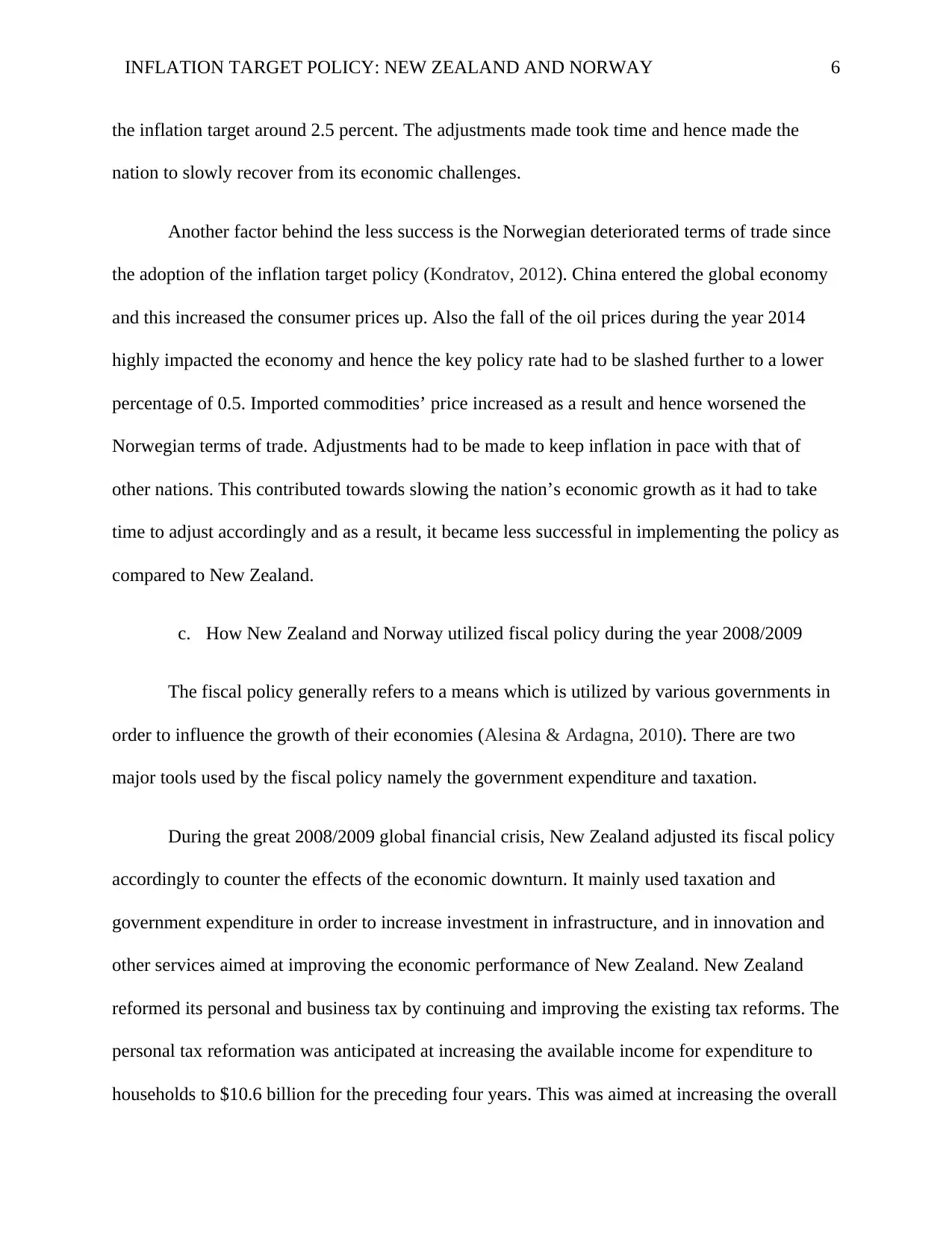
INFLATION TARGET POLICY: NEW ZEALAND AND NORWAY 6
the inflation target around 2.5 percent. The adjustments made took time and hence made the
nation to slowly recover from its economic challenges.
Another factor behind the less success is the Norwegian deteriorated terms of trade since
the adoption of the inflation target policy (Kondratov, 2012). China entered the global economy
and this increased the consumer prices up. Also the fall of the oil prices during the year 2014
highly impacted the economy and hence the key policy rate had to be slashed further to a lower
percentage of 0.5. Imported commodities’ price increased as a result and hence worsened the
Norwegian terms of trade. Adjustments had to be made to keep inflation in pace with that of
other nations. This contributed towards slowing the nation’s economic growth as it had to take
time to adjust accordingly and as a result, it became less successful in implementing the policy as
compared to New Zealand.
c. How New Zealand and Norway utilized fiscal policy during the year 2008/2009
The fiscal policy generally refers to a means which is utilized by various governments in
order to influence the growth of their economies (Alesina & Ardagna, 2010). There are two
major tools used by the fiscal policy namely the government expenditure and taxation.
During the great 2008/2009 global financial crisis, New Zealand adjusted its fiscal policy
accordingly to counter the effects of the economic downturn. It mainly used taxation and
government expenditure in order to increase investment in infrastructure, and in innovation and
other services aimed at improving the economic performance of New Zealand. New Zealand
reformed its personal and business tax by continuing and improving the existing tax reforms. The
personal tax reformation was anticipated at increasing the available income for expenditure to
households to $10.6 billion for the preceding four years. This was aimed at increasing the overall
the inflation target around 2.5 percent. The adjustments made took time and hence made the
nation to slowly recover from its economic challenges.
Another factor behind the less success is the Norwegian deteriorated terms of trade since
the adoption of the inflation target policy (Kondratov, 2012). China entered the global economy
and this increased the consumer prices up. Also the fall of the oil prices during the year 2014
highly impacted the economy and hence the key policy rate had to be slashed further to a lower
percentage of 0.5. Imported commodities’ price increased as a result and hence worsened the
Norwegian terms of trade. Adjustments had to be made to keep inflation in pace with that of
other nations. This contributed towards slowing the nation’s economic growth as it had to take
time to adjust accordingly and as a result, it became less successful in implementing the policy as
compared to New Zealand.
c. How New Zealand and Norway utilized fiscal policy during the year 2008/2009
The fiscal policy generally refers to a means which is utilized by various governments in
order to influence the growth of their economies (Alesina & Ardagna, 2010). There are two
major tools used by the fiscal policy namely the government expenditure and taxation.
During the great 2008/2009 global financial crisis, New Zealand adjusted its fiscal policy
accordingly to counter the effects of the economic downturn. It mainly used taxation and
government expenditure in order to increase investment in infrastructure, and in innovation and
other services aimed at improving the economic performance of New Zealand. New Zealand
reformed its personal and business tax by continuing and improving the existing tax reforms. The
personal tax reformation was anticipated at increasing the available income for expenditure to
households to $10.6 billion for the preceding four years. This was aimed at increasing the overall
⊘ This is a preview!⊘
Do you want full access?
Subscribe today to unlock all pages.

Trusted by 1+ million students worldwide
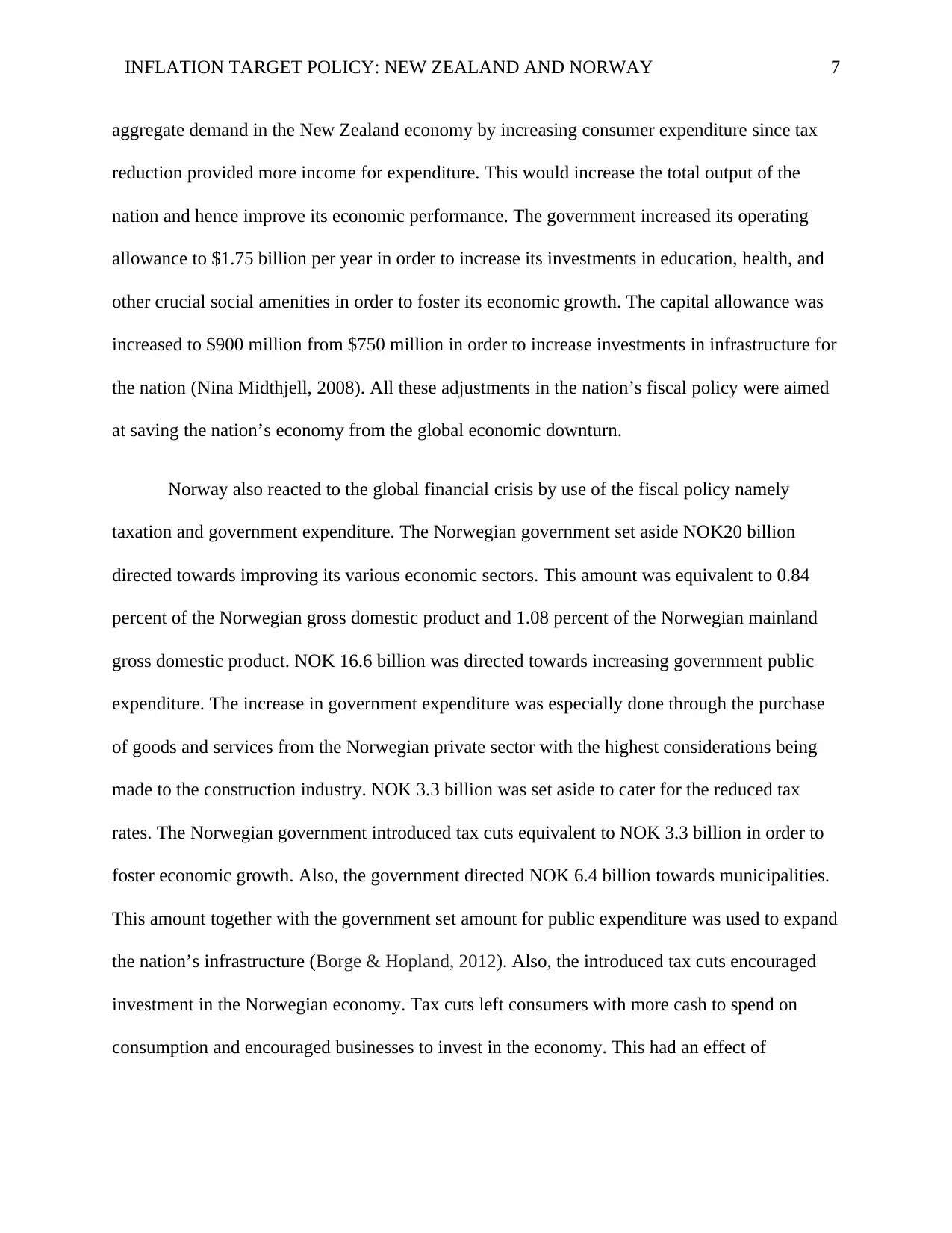
INFLATION TARGET POLICY: NEW ZEALAND AND NORWAY 7
aggregate demand in the New Zealand economy by increasing consumer expenditure since tax
reduction provided more income for expenditure. This would increase the total output of the
nation and hence improve its economic performance. The government increased its operating
allowance to $1.75 billion per year in order to increase its investments in education, health, and
other crucial social amenities in order to foster its economic growth. The capital allowance was
increased to $900 million from $750 million in order to increase investments in infrastructure for
the nation (Nina Midthjell, 2008). All these adjustments in the nation’s fiscal policy were aimed
at saving the nation’s economy from the global economic downturn.
Norway also reacted to the global financial crisis by use of the fiscal policy namely
taxation and government expenditure. The Norwegian government set aside NOK20 billion
directed towards improving its various economic sectors. This amount was equivalent to 0.84
percent of the Norwegian gross domestic product and 1.08 percent of the Norwegian mainland
gross domestic product. NOK 16.6 billion was directed towards increasing government public
expenditure. The increase in government expenditure was especially done through the purchase
of goods and services from the Norwegian private sector with the highest considerations being
made to the construction industry. NOK 3.3 billion was set aside to cater for the reduced tax
rates. The Norwegian government introduced tax cuts equivalent to NOK 3.3 billion in order to
foster economic growth. Also, the government directed NOK 6.4 billion towards municipalities.
This amount together with the government set amount for public expenditure was used to expand
the nation’s infrastructure (Borge & Hopland, 2012). Also, the introduced tax cuts encouraged
investment in the Norwegian economy. Tax cuts left consumers with more cash to spend on
consumption and encouraged businesses to invest in the economy. This had an effect of
aggregate demand in the New Zealand economy by increasing consumer expenditure since tax
reduction provided more income for expenditure. This would increase the total output of the
nation and hence improve its economic performance. The government increased its operating
allowance to $1.75 billion per year in order to increase its investments in education, health, and
other crucial social amenities in order to foster its economic growth. The capital allowance was
increased to $900 million from $750 million in order to increase investments in infrastructure for
the nation (Nina Midthjell, 2008). All these adjustments in the nation’s fiscal policy were aimed
at saving the nation’s economy from the global economic downturn.
Norway also reacted to the global financial crisis by use of the fiscal policy namely
taxation and government expenditure. The Norwegian government set aside NOK20 billion
directed towards improving its various economic sectors. This amount was equivalent to 0.84
percent of the Norwegian gross domestic product and 1.08 percent of the Norwegian mainland
gross domestic product. NOK 16.6 billion was directed towards increasing government public
expenditure. The increase in government expenditure was especially done through the purchase
of goods and services from the Norwegian private sector with the highest considerations being
made to the construction industry. NOK 3.3 billion was set aside to cater for the reduced tax
rates. The Norwegian government introduced tax cuts equivalent to NOK 3.3 billion in order to
foster economic growth. Also, the government directed NOK 6.4 billion towards municipalities.
This amount together with the government set amount for public expenditure was used to expand
the nation’s infrastructure (Borge & Hopland, 2012). Also, the introduced tax cuts encouraged
investment in the Norwegian economy. Tax cuts left consumers with more cash to spend on
consumption and encouraged businesses to invest in the economy. This had an effect of
Paraphrase This Document
Need a fresh take? Get an instant paraphrase of this document with our AI Paraphraser
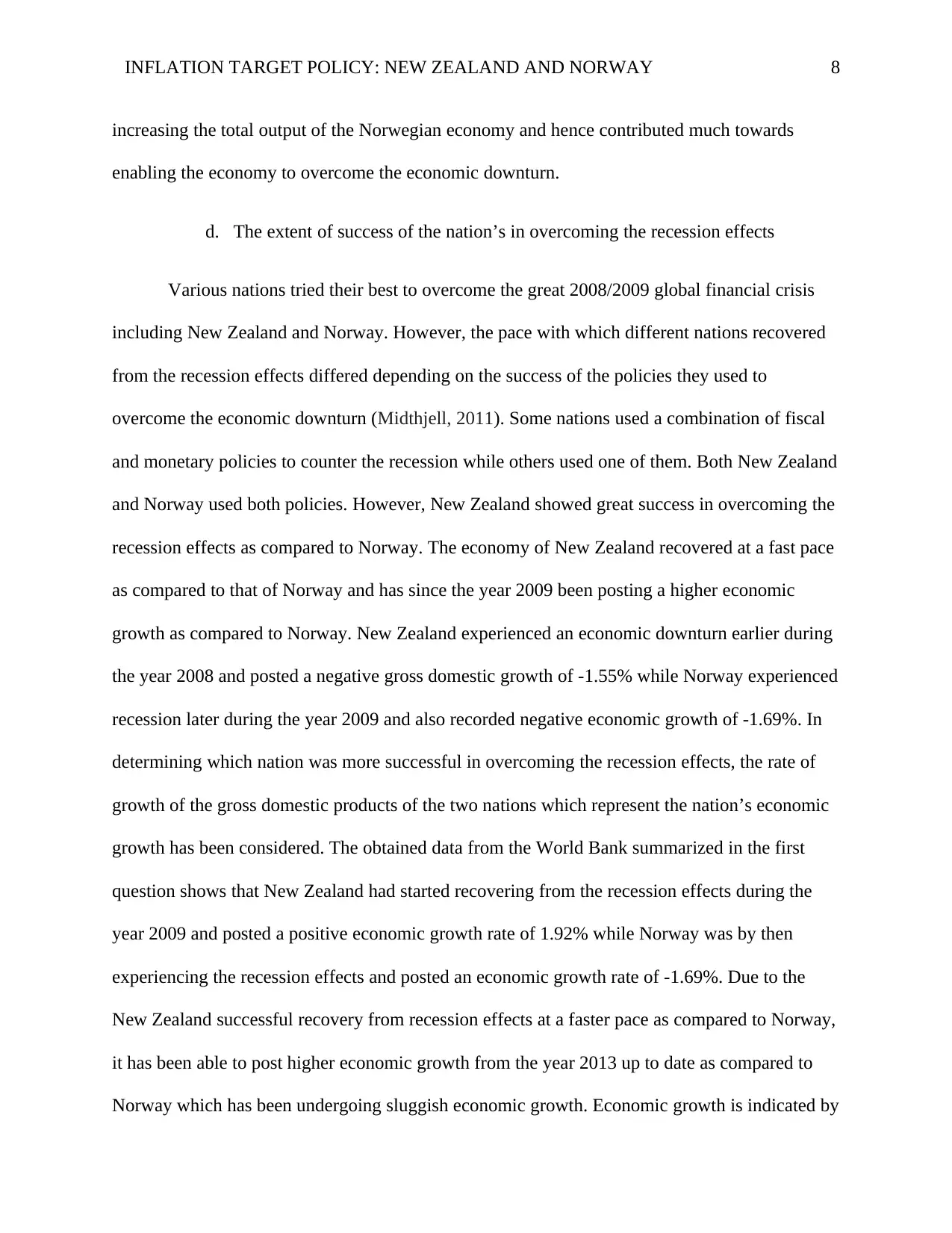
INFLATION TARGET POLICY: NEW ZEALAND AND NORWAY 8
increasing the total output of the Norwegian economy and hence contributed much towards
enabling the economy to overcome the economic downturn.
d. The extent of success of the nation’s in overcoming the recession effects
Various nations tried their best to overcome the great 2008/2009 global financial crisis
including New Zealand and Norway. However, the pace with which different nations recovered
from the recession effects differed depending on the success of the policies they used to
overcome the economic downturn (Midthjell, 2011). Some nations used a combination of fiscal
and monetary policies to counter the recession while others used one of them. Both New Zealand
and Norway used both policies. However, New Zealand showed great success in overcoming the
recession effects as compared to Norway. The economy of New Zealand recovered at a fast pace
as compared to that of Norway and has since the year 2009 been posting a higher economic
growth as compared to Norway. New Zealand experienced an economic downturn earlier during
the year 2008 and posted a negative gross domestic growth of -1.55% while Norway experienced
recession later during the year 2009 and also recorded negative economic growth of -1.69%. In
determining which nation was more successful in overcoming the recession effects, the rate of
growth of the gross domestic products of the two nations which represent the nation’s economic
growth has been considered. The obtained data from the World Bank summarized in the first
question shows that New Zealand had started recovering from the recession effects during the
year 2009 and posted a positive economic growth rate of 1.92% while Norway was by then
experiencing the recession effects and posted an economic growth rate of -1.69%. Due to the
New Zealand successful recovery from recession effects at a faster pace as compared to Norway,
it has been able to post higher economic growth from the year 2013 up to date as compared to
Norway which has been undergoing sluggish economic growth. Economic growth is indicated by
increasing the total output of the Norwegian economy and hence contributed much towards
enabling the economy to overcome the economic downturn.
d. The extent of success of the nation’s in overcoming the recession effects
Various nations tried their best to overcome the great 2008/2009 global financial crisis
including New Zealand and Norway. However, the pace with which different nations recovered
from the recession effects differed depending on the success of the policies they used to
overcome the economic downturn (Midthjell, 2011). Some nations used a combination of fiscal
and monetary policies to counter the recession while others used one of them. Both New Zealand
and Norway used both policies. However, New Zealand showed great success in overcoming the
recession effects as compared to Norway. The economy of New Zealand recovered at a fast pace
as compared to that of Norway and has since the year 2009 been posting a higher economic
growth as compared to Norway. New Zealand experienced an economic downturn earlier during
the year 2008 and posted a negative gross domestic growth of -1.55% while Norway experienced
recession later during the year 2009 and also recorded negative economic growth of -1.69%. In
determining which nation was more successful in overcoming the recession effects, the rate of
growth of the gross domestic products of the two nations which represent the nation’s economic
growth has been considered. The obtained data from the World Bank summarized in the first
question shows that New Zealand had started recovering from the recession effects during the
year 2009 and posted a positive economic growth rate of 1.92% while Norway was by then
experiencing the recession effects and posted an economic growth rate of -1.69%. Due to the
New Zealand successful recovery from recession effects at a faster pace as compared to Norway,
it has been able to post higher economic growth from the year 2013 up to date as compared to
Norway which has been undergoing sluggish economic growth. Economic growth is indicated by
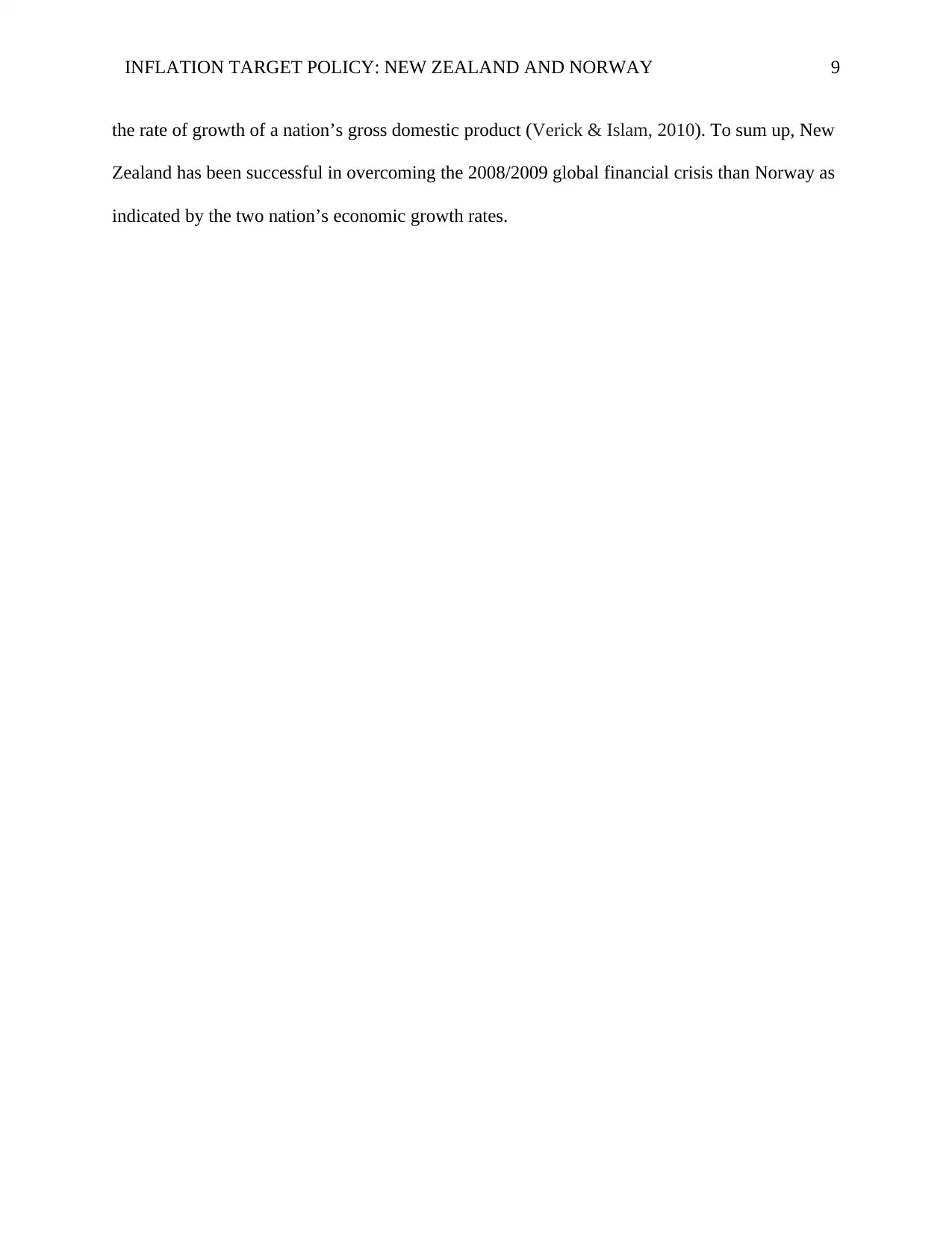
INFLATION TARGET POLICY: NEW ZEALAND AND NORWAY 9
the rate of growth of a nation’s gross domestic product (Verick & Islam, 2010). To sum up, New
Zealand has been successful in overcoming the 2008/2009 global financial crisis than Norway as
indicated by the two nation’s economic growth rates.
the rate of growth of a nation’s gross domestic product (Verick & Islam, 2010). To sum up, New
Zealand has been successful in overcoming the 2008/2009 global financial crisis than Norway as
indicated by the two nation’s economic growth rates.
⊘ This is a preview!⊘
Do you want full access?
Subscribe today to unlock all pages.

Trusted by 1+ million students worldwide
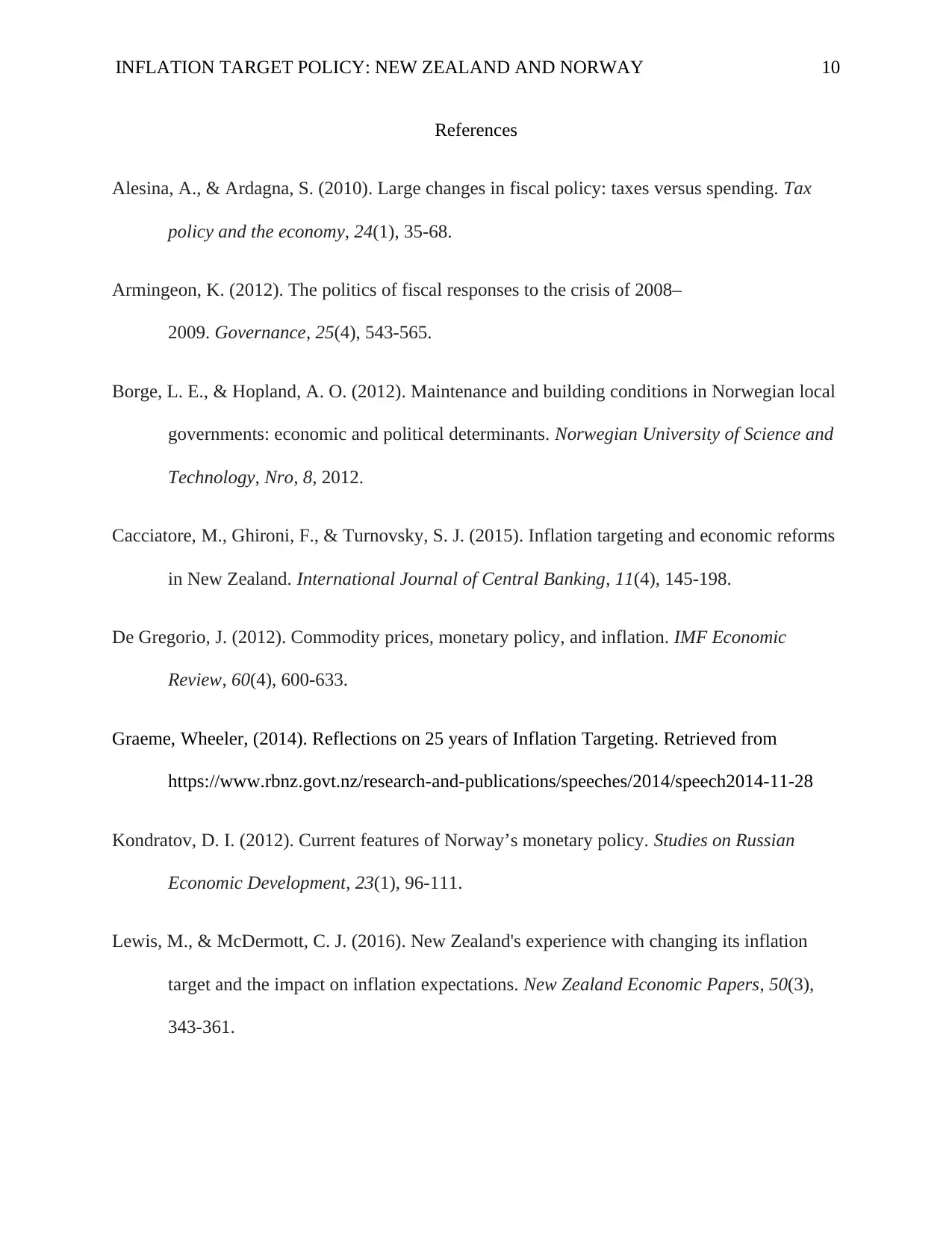
INFLATION TARGET POLICY: NEW ZEALAND AND NORWAY 10
References
Alesina, A., & Ardagna, S. (2010). Large changes in fiscal policy: taxes versus spending. Tax
policy and the economy, 24(1), 35-68.
Armingeon, K. (2012). The politics of fiscal responses to the crisis of 2008–
2009. Governance, 25(4), 543-565.
Borge, L. E., & Hopland, A. O. (2012). Maintenance and building conditions in Norwegian local
governments: economic and political determinants. Norwegian University of Science and
Technology, Nro, 8, 2012.
Cacciatore, M., Ghironi, F., & Turnovsky, S. J. (2015). Inflation targeting and economic reforms
in New Zealand. International Journal of Central Banking, 11(4), 145-198.
De Gregorio, J. (2012). Commodity prices, monetary policy, and inflation. IMF Economic
Review, 60(4), 600-633.
Graeme, Wheeler, (2014). Reflections on 25 years of Inflation Targeting. Retrieved from
https://www.rbnz.govt.nz/research-and-publications/speeches/2014/speech2014-11-28
Kondratov, D. I. (2012). Current features of Norway’s monetary policy. Studies on Russian
Economic Development, 23(1), 96-111.
Lewis, M., & McDermott, C. J. (2016). New Zealand's experience with changing its inflation
target and the impact on inflation expectations. New Zealand Economic Papers, 50(3),
343-361.
References
Alesina, A., & Ardagna, S. (2010). Large changes in fiscal policy: taxes versus spending. Tax
policy and the economy, 24(1), 35-68.
Armingeon, K. (2012). The politics of fiscal responses to the crisis of 2008–
2009. Governance, 25(4), 543-565.
Borge, L. E., & Hopland, A. O. (2012). Maintenance and building conditions in Norwegian local
governments: economic and political determinants. Norwegian University of Science and
Technology, Nro, 8, 2012.
Cacciatore, M., Ghironi, F., & Turnovsky, S. J. (2015). Inflation targeting and economic reforms
in New Zealand. International Journal of Central Banking, 11(4), 145-198.
De Gregorio, J. (2012). Commodity prices, monetary policy, and inflation. IMF Economic
Review, 60(4), 600-633.
Graeme, Wheeler, (2014). Reflections on 25 years of Inflation Targeting. Retrieved from
https://www.rbnz.govt.nz/research-and-publications/speeches/2014/speech2014-11-28
Kondratov, D. I. (2012). Current features of Norway’s monetary policy. Studies on Russian
Economic Development, 23(1), 96-111.
Lewis, M., & McDermott, C. J. (2016). New Zealand's experience with changing its inflation
target and the impact on inflation expectations. New Zealand Economic Papers, 50(3),
343-361.
Paraphrase This Document
Need a fresh take? Get an instant paraphrase of this document with our AI Paraphraser
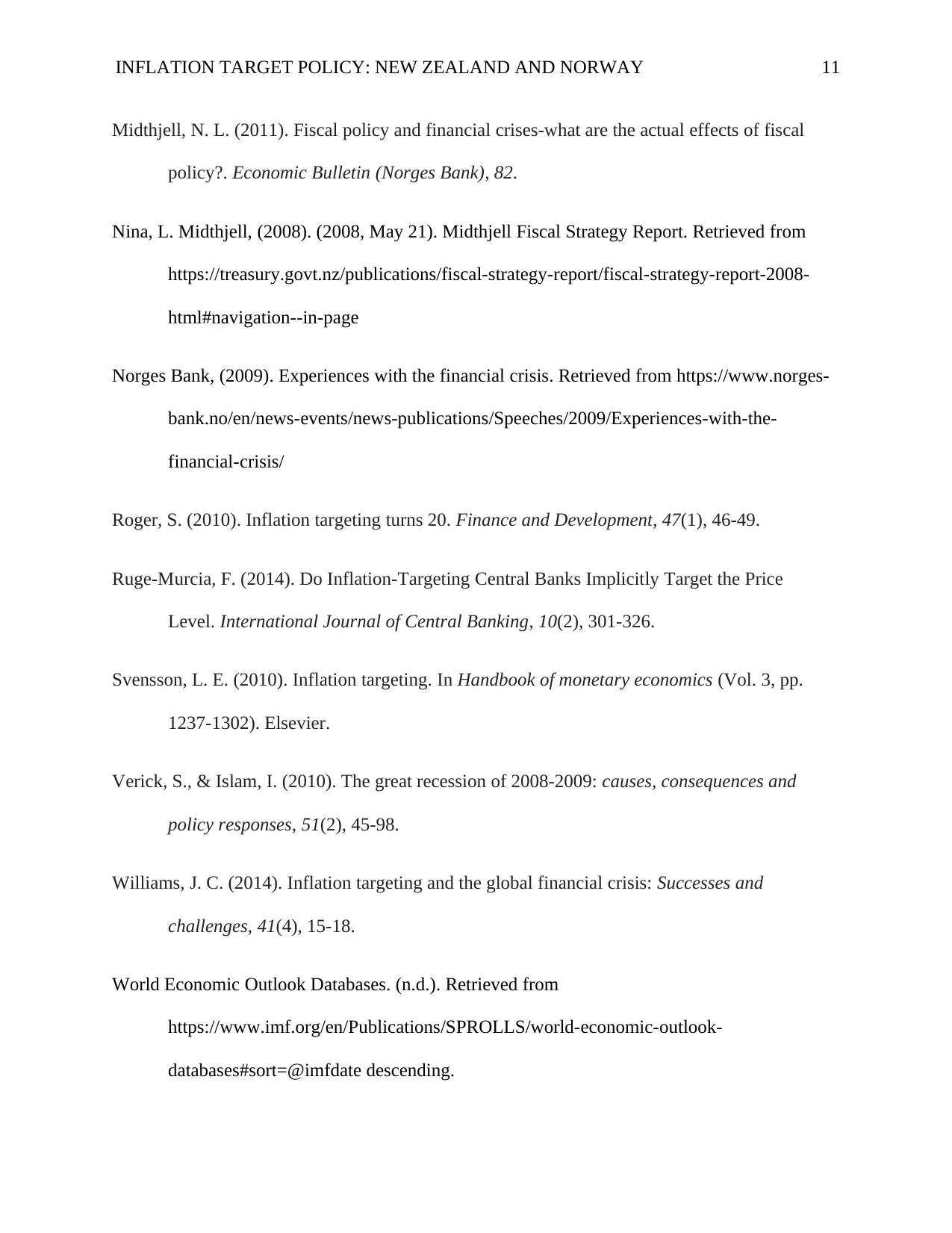
INFLATION TARGET POLICY: NEW ZEALAND AND NORWAY 11
Midthjell, N. L. (2011). Fiscal policy and financial crises-what are the actual effects of fiscal
policy?. Economic Bulletin (Norges Bank), 82.
Nina, L. Midthjell, (2008). (2008, May 21). Midthjell Fiscal Strategy Report. Retrieved from
https://treasury.govt.nz/publications/fiscal-strategy-report/fiscal-strategy-report-2008-
html#navigation--in-page
Norges Bank, (2009). Experiences with the financial crisis. Retrieved from https://www.norges-
bank.no/en/news-events/news-publications/Speeches/2009/Experiences-with-the-
financial-crisis/
Roger, S. (2010). Inflation targeting turns 20. Finance and Development, 47(1), 46-49.
Ruge-Murcia, F. (2014). Do Inflation-Targeting Central Banks Implicitly Target the Price
Level. International Journal of Central Banking, 10(2), 301-326.
Svensson, L. E. (2010). Inflation targeting. In Handbook of monetary economics (Vol. 3, pp.
1237-1302). Elsevier.
Verick, S., & Islam, I. (2010). The great recession of 2008-2009: causes, consequences and
policy responses, 51(2), 45-98.
Williams, J. C. (2014). Inflation targeting and the global financial crisis: Successes and
challenges, 41(4), 15-18.
World Economic Outlook Databases. (n.d.). Retrieved from
https://www.imf.org/en/Publications/SPROLLS/world-economic-outlook-
databases#sort=@imfdate descending.
Midthjell, N. L. (2011). Fiscal policy and financial crises-what are the actual effects of fiscal
policy?. Economic Bulletin (Norges Bank), 82.
Nina, L. Midthjell, (2008). (2008, May 21). Midthjell Fiscal Strategy Report. Retrieved from
https://treasury.govt.nz/publications/fiscal-strategy-report/fiscal-strategy-report-2008-
html#navigation--in-page
Norges Bank, (2009). Experiences with the financial crisis. Retrieved from https://www.norges-
bank.no/en/news-events/news-publications/Speeches/2009/Experiences-with-the-
financial-crisis/
Roger, S. (2010). Inflation targeting turns 20. Finance and Development, 47(1), 46-49.
Ruge-Murcia, F. (2014). Do Inflation-Targeting Central Banks Implicitly Target the Price
Level. International Journal of Central Banking, 10(2), 301-326.
Svensson, L. E. (2010). Inflation targeting. In Handbook of monetary economics (Vol. 3, pp.
1237-1302). Elsevier.
Verick, S., & Islam, I. (2010). The great recession of 2008-2009: causes, consequences and
policy responses, 51(2), 45-98.
Williams, J. C. (2014). Inflation targeting and the global financial crisis: Successes and
challenges, 41(4), 15-18.
World Economic Outlook Databases. (n.d.). Retrieved from
https://www.imf.org/en/Publications/SPROLLS/world-economic-outlook-
databases#sort=@imfdate descending.
1 out of 11
Your All-in-One AI-Powered Toolkit for Academic Success.
+13062052269
info@desklib.com
Available 24*7 on WhatsApp / Email
![[object Object]](/_next/static/media/star-bottom.7253800d.svg)
Unlock your academic potential
Copyright © 2020–2025 A2Z Services. All Rights Reserved. Developed and managed by ZUCOL.

